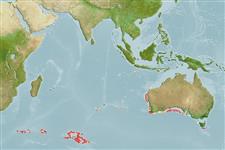ইলাসমোব্রাঙ্কি (হাঙ্গর এবং রে) (sharks and rays) >
Squaliformes (Sleeper and dogfish sharks) >
Centrophoridae (Gulper sharks)
Etymology: Centrophorus: centr[um] (L.), prickle or sharp point; phorus, from phoreus (Gr.), bearer or carrier, referring to grooved spines on dorsal fins. (See ETYFish); westraliensis: -ensis, Latin suffix denoting place: Western Australia, only known area of occurrence. (See ETYFish).
Environment: milieu / climate zone / depth range / distribution range
বাস্তুসংস্থান
সামুদ্রিক ব্যথিডিমারসাল সমুদ্র তলদেশবিহারী; গভীরতার পরিসীমা 616 - 750 m (Ref. 76933). Tropical
Eastern Indian Ocean: Western Australia.
আকৃতি / ওজন / Age
Maturity: Lm ? range ? - ? cm
Max length : 90.9 cm TL (female)
This moderate-sized species has the following set of adult characters: length of pre-second dorsal 63.8-64.9% TL, 8.8-9.7 times dorsal-caudal space; length of pre-first dorsal 31.3-32.7% TL; interdorsal space 20.3-21.5% TL, 2.8-3.1 times dorsal-caudal space; dorsal-caudal space 6.7-7.3% TL, 4.4-4.9 in pectoral-pelvic space; long and moderately robust head, its length 23.2-24.7% TL, 3.1- 3.2 times mouth width, its width 11.7–12.8% TL, 5.1-5.5 in pre-second dorsal length; width at anterior of nostrils 7.1-7.6% TL; long snout, its preoral length 10.9-12.4% TL, 2.0-2.2 times head height at anterior of mouth, 1.4-1.6 times mouth width; horizontal preorbital length 7.0-7.8% TL; horizontal prenarial length 4.5-4.9% TL; moderately large mouth, its width 7.6–7.8% TL; large pectoral fin, its anterior margin 12.9-14.2% TL, 2.6-2.8 times base length; large caudal fin, its dorsal caudal margin 17.4-20.2% TL; 2.6-2.9 times dorsal-caudal space; moderately-sized first dorsal fin, its height 5.5-6.4% TL, with relatively robust spine, its base width 1.1-1.2% TL; dorsal fins of juveniles have a distinct blackish oblique blotch anteriorly and a white blotch on the upper posterior margin; in adults a less distinct dark blotch which is usually still apparent in fresh specimens and with white blotch restricted to a narrow white posterior margin which can be indistinct in larger preserved specimens; females and an immature male with upper teeth strongly oblique, similar in shape, but much smaller than lower teeth; 38/29.teeth count in holotype; adults with flank denticles flat, not overlapping, with scalloped edges; 112-117 (mean 115.3) total vertebral centra; 55-57 (55.8) monospondylous precaudal centra; 29-33 (31) diplospondylous precaudal centra; 85-88 (86.8) precaudal centra; 27-30 (28.5) diplospondylous caudal centra (Ref. 76933).
Life cycle and mating behavior
পরিপক্কতা | প্রজনন | ডিম ছাড়া | ডিমসমূহ | ডিম্বধারন ক্ষমতা | শুককীট
White, W.T., D.A. Ebert and L.J.V. Compagno, 2008. Description of two new species of gulper sharks, genus Centrophorus (Chondrichthyes: Squaliformes: Centrophoridae) from Australia. pp. 1-21. In P.R. Last, W.T. White and J.J. Pogonoski (eds). Descriptions of new Australian chondrichthyans. CSIRO Marine and Atmospheric Research Paper no. 22. 365 p. (Ref. 76933)
IUCN Red List Status (Ref. 130435)
Threat to humans
Harmless
Human uses
আরো তথ্য
প্রচলিত নাম সমূহপ্রতিনাম সমূহবিপাকশিকারী প্রাণী সমূহপরিবেশ বিষাক্ততাবিদ্যাপ্রজনন পরিপক্কতা ডিম ছাড়া ডিমের সংগ্রহ ডিম্বধারন ক্ষমতা ডিমসমূহEgg development
Age/Sizeবৃদ্ধিLength-weightLength-lengthLength-frequenciesমরফোমেট্রিক্সবহিঃ অঙ্গ সংস্থানশুককীট শুককীটের সত্রিুয়তা নির্বাচন প্রাচুর্য BRUVS
সূত্র সংখ্যা এ্যাকুয়াকালচার (জলজ পালন) এ্যাকুয়াকালচার নকশা বংশ বংশানুগতিবিদ্যাElectrophoresesউতরাধিকার সুত্রে পাওয়া যোগ্যতারোগ প্রক্রিয়াজাতকরণ NutrientsMass conversion
সহযোগী ছবি সমূহStamps, Coins Misc.শব্দ ক্রোমোজোমের ধরণ গতি সাতাঁরের কায়দা ফুলকা এলাকাOtolithsমস্তিস্ক সমূহদৃষ্টি
হাতিয়ার
Special reports
Download XML
ইন্টারনেট সুত্র
Estimates based on models
Preferred temperature (Ref.
123201): 1.7 - 8.2, mean 6.9 °C (based on 11 cells).
Phylogenetic diversity index (Ref.
82804): PD
50 = 0.5001 [Uniqueness, from 0.5 = low to 2.0 = high].
Bayesian length-weight: a=0.00263 (0.00121 - 0.00572), b=3.18 (2.99 - 3.37), in cm total length, based on LWR estimates for this (Sub)family-body shape (Ref.
93245).
ট্রফিক পর্যায়ে (Ref.
69278): 4.3 ±0.3 se; based on size and trophs of closest relatives
স্থিতিস্থাপক (Ref.
120179): অত্যন্ত কম , সর্বনিম্ন প্রজন দ্বিগুনের সময় ১৪ বৎসর (Preliminary K or Fecundity.).
Fishing Vulnerability (Ref.
59153): High vulnerability (56 of 100).
